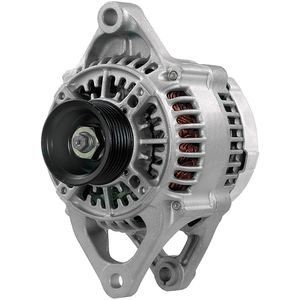 Find the Right Alternator for Your Vehicle
Find the Right Alternator for Your Vehicle
Understanding the Role of Your Alternator
When delving into the world of vehicle alternators, it’s essential to recognize that modern cars exclusively utilize AC generators. While direct current (DC) generators have historical significance, their inefficiency at lower engine speeds led to their obsolescence. Today’s vehicles rely on alternators to generate the necessary DC power, even though alternators inherently produce alternating current (AC).
An automotive alternator is a clever device that converts mechanical energy from your engine into electrical energy. This process involves several key components working in harmony:
- Belt-Driven Pulley: This crucial part, connected to the engine’s crankshaft via a belt, initiates the alternator’s rotation. You can find replacement pulleys here.
- Rotor Assembly: Positioned inside the alternator, this rotating component houses electromagnets that are set in motion by the pulley.
- Stator: This stationary element surrounds the rotor and contains wire coils.
As the engine spins the alternator pulley, the rotor assembly’s electromagnets move past the stator coils. This interaction induces a small alternating electric current within the coils. This AC current is then converted to DC current through a process called rectification. The resulting DC power is then directed to the car’s battery and electrical system, providing power for all electrical components. The strength of the electromagnetic field directly influences the generated current. Therefore, as engine RPMs increase, the alternator produces more current to accommodate higher electrical demands. It’s a remarkably efficient system for turning engine motion into electricity to power your vehicle.
Exploring Alternator Types: New vs. Remanufactured
When browsing alternator options, you’ll primarily encounter two categories: new and remanufactured (or reman). A new alternator is exactly as it sounds – composed entirely of brand-new components and never previously used. Conversely, a remanufactured alternator has been used before, likely returned as a core part. These units are disassembled, thoroughly cleaned, and rebuilt. During the remanufacturing process, any worn or defective parts are replaced with new ones to meet performance standards.
Choosing between new and remanufactured often comes down to budget and personal preference. Remanufactured alternators typically offer a slightly lower price point while often maintaining comparable warranty coverage to their new counterparts. While a new alternator might offer a sense of guaranteed longevity, remanufactured options provide a cost-effective and environmentally conscious alternative.
Key Features to Consider When Choosing an Alternator
Replacing a failing alternator involves considering several important specifications and features to ensure optimal performance and compatibility. Not all alternators are created equal, and focusing on the following aspects will help you make an informed decision:
-
Amperage Output: The maximum current an alternator can produce is a crucial specification, clearly indicated on the alternator’s label and online product details. This rating is critical because the same vehicle model can be equipped with alternators of varying capacities. While you can often upgrade to an alternator with a higher amperage output to handle increased electrical loads, it’s crucial to never downgrade. Using an alternator with insufficient amperage can lead to premature wear and failure due to overloading.
-
Voltage Regulation: A voltage regulator is essential for maintaining a stable voltage output. Some alternators feature internal voltage regulators, while others utilize external ones. Selecting the correct type is vital for compatibility with your vehicle’s electrical system; mismatched regulators are typically incompatible.
-
Physical Size and Dimensions: The physical dimensions of the alternator are paramount for a proper fit. The replacement alternator must match the original in terms of mounting bolt alignment and housing size to ensure seamless installation without interference. Equally important is the pulley positioning; it must align perfectly with the drive belt to ensure efficient power transfer.
-
Noise Level: A slight whirring sound from an alternator is normal during operation. However, lower-quality alternators may produce significantly louder and more noticeable noise compared to premium parts. If noise is a concern, opting for reputable brands known for quality and quieter operation is advisable.
-
Warranty: Warranty coverage varies among alternator brands and types. Budget-friendly alternators often come with shorter warranty periods. In contrast, premium brands may offer extended warranties, even limited lifetime warranties in some cases. If you plan to keep your vehicle for an extended period, considering the warranty duration can be a significant factor in your alternator selection.
Vehicle Compatibility: The Non-Negotiable Factor
Beyond the desirable features, vehicle compatibility remains the most critical consideration when choosing an alternator. Even the most feature-rich new alternator is useless if it’s not designed to work with your specific vehicle. Three key compatibility factors must be addressed:
Make and Model Specificity
As mentioned earlier, physical dimensions are paramount. The replacement alternator must be a direct fit, precisely like the original component it’s replacing. Automotive engineers carefully select alternators to meet the specific electrical demands of each vehicle model, considering both idle and high-load conditions. Attempting to install an incompatible alternator is often futile, resulting in wasted time and money, as it simply won’t function correctly or even be installable.
Electrical System Requirements Match
Your vehicle’s electrical system is designed to operate within a specific amperage range. The replacement alternator must provide sufficient output to power all electrical components reliably. Furthermore, electrical connectors must be compatible. Incorrect wiring connectors or a different number of wires can render an alternator incompatible with your vehicle’s electrical system.
Mounting and Belt Tensioning Alignment
Compatibility extends to mounting points and belt system integration. Everything from the mounting bolt hole locations and spacing to the pulley size and width must match the original alternator. Mismatched mounting points may prevent installation altogether or, at best, hinder proper belt tensioning, leading to performance issues.
Factors Influencing Alternator Performance
Several factors can impact how efficiently and reliably your alternator operates. Understanding these factors can help you prolong the lifespan of your alternator and address potential issues proactively:
-
Electrical Load Demands: The greater the electrical load placed on the alternator, the harder it has to work to generate sufficient current. Excessive electrical loads can cause the alternator to overheat, potentially leading to premature failure. Minimize unnecessary electrical drain whenever possible.
-
Drive Belt Tension: The alternator relies on the engine’s accessory belt for rotation. If the belt is too loose, it can slip on the alternator pulley, reducing rotational speed and consequently, power output. Regular belt tension checks and adjustments are important for optimal alternator performance.
-
Operating Temperature: Maintaining a reasonable operating temperature is crucial for alternator longevity. Overheating can damage internal components and ultimately lead to alternator failure. Ensure adequate airflow around the alternator to facilitate cooling.
-
Age and Wear: Like any mechanical component, alternators are subject to wear and tear over time. Especially in vehicles with high electrical demands, alternators can wear out. Bearings and internal electrical components can degrade, leading to reduced performance or complete failure. Regular vehicle maintenance, including electrical system checks, can help identify potential alternator issues early on.
Keeping these factors in mind when selecting a new alternator is wise. Opt for a part designed for efficient cooling, capable of handling your vehicle’s electrical load, and built for long-term durability.
Step-by-Step Guide: Choosing the Right Alternator for Your Car
Selecting the correct alternator for your car involves a straightforward two-pronged approach. First and foremost, prioritize vehicle compatibility. This means choosing a direct replacement part specifically engineered for your vehicle’s make, model, and year. The easiest and most reliable way to ensure compatibility is to utilize online parts finders. Enter your vehicle’s year, make, model, and engine details. The system will then filter results to display only alternators that are confirmed to fit your car. When reviewing options, ensure that the amperage output of the replacement alternator is equal to or greater than your original alternator’s output.
Secondly, once you have a list of compatible alternators, focus on features and customer reviews. Consider factors like warranty duration. Do you prefer a new or remanufactured unit? Read reviews from other vehicle owners to gauge real-world performance and reliability feedback for the alternators you are considering.
For a wide selection of alternators designed to fit your vehicle, consider shopping at your local AutoZone. AutoZone offers a comprehensive range of alternators from trusted brands like Duralast, Duralast Gold, and Valucraft, all intended to be direct-fit replacements for various vehicles. You can easily browse their online catalog or consult with an AutoZoner in-store for personalized assistance in finding the perfect alternator match for your car.
Frequently Asked Questions About Alternator Selection
Q: How do I determine the correct alternator to buy for my car?
A: Alternator selection is primarily based on your vehicle’s year, make, model, and engine size. Inputting these details into a parts finder tool will display compatible options. Choose an alternator with the same or higher amperage rating as your original unit.
Q: What size alternator do I need for my vehicle?
A: Your replacement alternator should be the same physical size and specification as the alternator you are removing. Focus on finding a direct replacement part specified for your vehicle.
Q: What amperage rating is considered good for a car alternator?
A: The appropriate amperage rating varies depending on the vehicle. Smaller passenger cars may use alternators rated at 100 amps or less, while larger SUVs or trucks can require alternators exceeding 200 amps. Consult your vehicle’s specifications or the original alternator’s rating for guidance.
Q: What voltage alternator is required for cars?
A: Virtually all passenger vehicles utilize a 12-volt electrical system. While nominally 12 volts, the actual charging voltage is typically closer to 14 volts.
Q: Is it acceptable to install an alternator with a higher amperage rating than the original?
A: In most cases, upgrading to a higher amperage alternator is permissible and can be beneficial, especially if you have added electrical accessories to your vehicle. However, it is never advisable to downgrade to an alternator with a lower amperage rating than the original, as this can lead to insufficient power and premature alternator failure.
